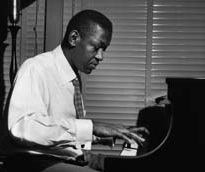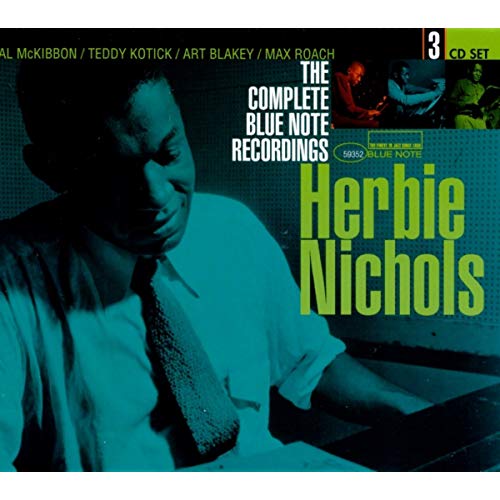117th Street – Herbie Nichols
A striking yet laid-back medium swinger, with a chromatically descending melody harmonized by circles of fourths. Lead sheets and a 2-stave Piano Melody Transcription from the recorded master take are available.
- Recording: Herbie Nichols - Complete Blue Note Recordings of Herbie Nichols
- Recorded on: August 7, 1955
- Label: Mosaic (MR5-118)
- Concert Key: F
- Vocal Range: , to
- Style: Swing (medium)
- Piano - Herbie Nichols
- Bass - Al McKibbon
- Drums - Max Roach
0:00
0:00
Buy MP3
Video
- Description
- Historical Notes
- Solos
- Piano Corner
- Bass Corner
- Drum Corner
- Guitar Corner
- Inside & Beyond
- Minus You
The melodic flow of 117th Street is not challenging to the ear, unlike many of Herbie's other compositions. Rhythmically (against the walking bass) and harmonically, it keeps gently propelling you forward.
Our lead sheets are created from careful examination of Herbie's original manuscript and his master take and alternate take recordings of this composition.
He only recorded this composition in a piano trio format. Fortunately we can study this composition from his two recorded takes. The drum indications on our lead sheets come from the master take. For quartet exploration, separate Trumpet and Tenor Sax lead sheets are available, as well as our other usual lead sheet editions.
Analysis:
This song is one of the slowest and most laid-back of Herbie Nichols' compositions from the Blue Note sessions. It makes creative use of a basic principle of tonal harmony: the third of a dominant chord is a half step above the seventh of the next dominant chord in the circle of fourths, and vice versa. In this song the melody descends in half steps on the thirds and sevenths while the bass line moves in fourths—one chord per beat for a measure, alternated with a measure of the tonic. The four dominant chords start on E♭ in the first measure, resulting in a tritone substitute cadence (G♭7 to F). The melody notes are mostly on upbeats, creating a dialogue between the chords and the bass—or, in a more classical sense, a series of suspensions. The same motif is repeated twice in F before the same chords leading to B♭—with the melody a half step lower (starting on the 7th where in the beginning it starts on the 3rd).
The A section's last phrase is like the first, but in the first A section it resolves to B instead of F, leading to Bb7 to connect back to Eb7 for the second A section, which ends on the tonic. Another difference between the two A sections is in the fifth measure, where the melody jumps up a fourth in the second A. The bridge is harmonically similar, but slows the circle of fourths to two chords per measure; the melody stays in half steps, swaying up and down in triplet figures. In the last two measures of the bridge these motions are broken up with two isolated dominant chords (Db7 and Bb7) and melodic phrases that add the major 7th on top of these chords - a strange clash but entirely intentional. The C section is extended to 10 measures: the 8 measures of the first A, followed by a resolution based on the opening phrase but a tritone lower with the chords starting on A instead of Eb.
The intro, as with many Nichols intros, is based on the last two measures. Here, the fourth chord (C7) is omitted, and the second measure repeats the first a major third lower, with slightly different rhythms and one extra melody note. As an intro, it is followed by a two-measure drum break; when it appears as a coda, there is no drum break.
A Piano Melody Transcription is available for the in and out heads of the master take; click on Piano Corner for more details.
Our lead sheets are created from careful examination of Herbie's original manuscript and his master take and alternate take recordings of this composition.
He only recorded this composition in a piano trio format. Fortunately we can study this composition from his two recorded takes. The drum indications on our lead sheets come from the master take. For quartet exploration, separate Trumpet and Tenor Sax lead sheets are available, as well as our other usual lead sheet editions.
Analysis:
This song is one of the slowest and most laid-back of Herbie Nichols' compositions from the Blue Note sessions. It makes creative use of a basic principle of tonal harmony: the third of a dominant chord is a half step above the seventh of the next dominant chord in the circle of fourths, and vice versa. In this song the melody descends in half steps on the thirds and sevenths while the bass line moves in fourths—one chord per beat for a measure, alternated with a measure of the tonic. The four dominant chords start on E♭ in the first measure, resulting in a tritone substitute cadence (G♭7 to F). The melody notes are mostly on upbeats, creating a dialogue between the chords and the bass—or, in a more classical sense, a series of suspensions. The same motif is repeated twice in F before the same chords leading to B♭—with the melody a half step lower (starting on the 7th where in the beginning it starts on the 3rd).
The A section's last phrase is like the first, but in the first A section it resolves to B instead of F, leading to Bb7 to connect back to Eb7 for the second A section, which ends on the tonic. Another difference between the two A sections is in the fifth measure, where the melody jumps up a fourth in the second A. The bridge is harmonically similar, but slows the circle of fourths to two chords per measure; the melody stays in half steps, swaying up and down in triplet figures. In the last two measures of the bridge these motions are broken up with two isolated dominant chords (Db7 and Bb7) and melodic phrases that add the major 7th on top of these chords - a strange clash but entirely intentional. The C section is extended to 10 measures: the 8 measures of the first A, followed by a resolution based on the opening phrase but a tritone lower with the chords starting on A instead of Eb.
The intro, as with many Nichols intros, is based on the last two measures. Here, the fourth chord (C7) is omitted, and the second measure repeats the first a major third lower, with slightly different rhythms and one extra melody note. As an intro, it is followed by a two-measure drum break; when it appears as a coda, there is no drum break.
A Piano Melody Transcription is available for the in and out heads of the master take; click on Piano Corner for more details.
This session from "The Complete Blue Note Recordings Of Herbie Nichols" was recorded at Rudy Van Gelder's legendary Hackensack Studio.
The two takes of 117th Street, like most of the songs from this August 7, 1955, recording session, were first released on the Mosaic box set of Herbie Nichols' complete Blue Note recordings. This song's alternate title is Enter Rhythm Street. Other recordings of 117th Street include a version on the eponymous 1991 debut album of the Dutch trio Clusone 3. Ted Rosenthal played a solo piano version on his live Maybeck Recital Hall recording in 1994, and pianist Kenny Drew, Jr. did a trio version in 1998 on his album "Winter Flower."
The two takes of 117th Street, like most of the songs from this August 7, 1955, recording session, were first released on the Mosaic box set of Herbie Nichols' complete Blue Note recordings. This song's alternate title is Enter Rhythm Street. Other recordings of 117th Street include a version on the eponymous 1991 debut album of the Dutch trio Clusone 3. Ted Rosenthal played a solo piano version on his live Maybeck Recital Hall recording in 1994, and pianist Kenny Drew, Jr. did a trio version in 1998 on his album "Winter Flower."
Our Piano Melody Transcription shows exactly how Herbie Nichols plays the head on the master take. Herbie takes the head out from the bridge; the B and C sections of this last chorus are included in the transcription. The A section melody is voiced in the right hand in parallel tritones (the descending thirds and sevenths), with the roots in the left hand in the same rhythms as the melody—going against the walking bass. In the bridge, the melody is a single line, with unusual left-hand voicings: two measures of an Em7 structure alternated with two measures of an E♭ major triad. These two chords are the opposite ends of the four-measure circle-of-fourths trajectory in the first half of the bridge, and the walking bass here is the only indication of the underlying changes. Herbie plays the melody of the out C section mostly up an octave, with slightly more varied rhythms than on the in head. This transcription has detailed articulations to give an in-depth look at Herbie Nichols' unique style.
Related Songs
Email Send 117th Street to a friend
Send this page to a friend via email. Add your name or email in the first field. In the second, add one or more email addresses, separated by a comma.

Herbie Nichols
January 3, 1919 – April 12, 1963
Don Sickler "On January 3, 2019, we were at the Van Gelder Recording Studio celebrating Herbie's 100th birthday with his family and pianists Frank Kimbrough and Glenn Zaleski. Both Frank and Glenn each recorded a previously unrecorded Herbie Nichols composition, on the same piano Herbie played for his Blue Note sessions. These were the initial recordings that started my new project, the Herbie Nichols Centennial Project, which debuts January 3, 2024. Read more...
There was a problem.
...

